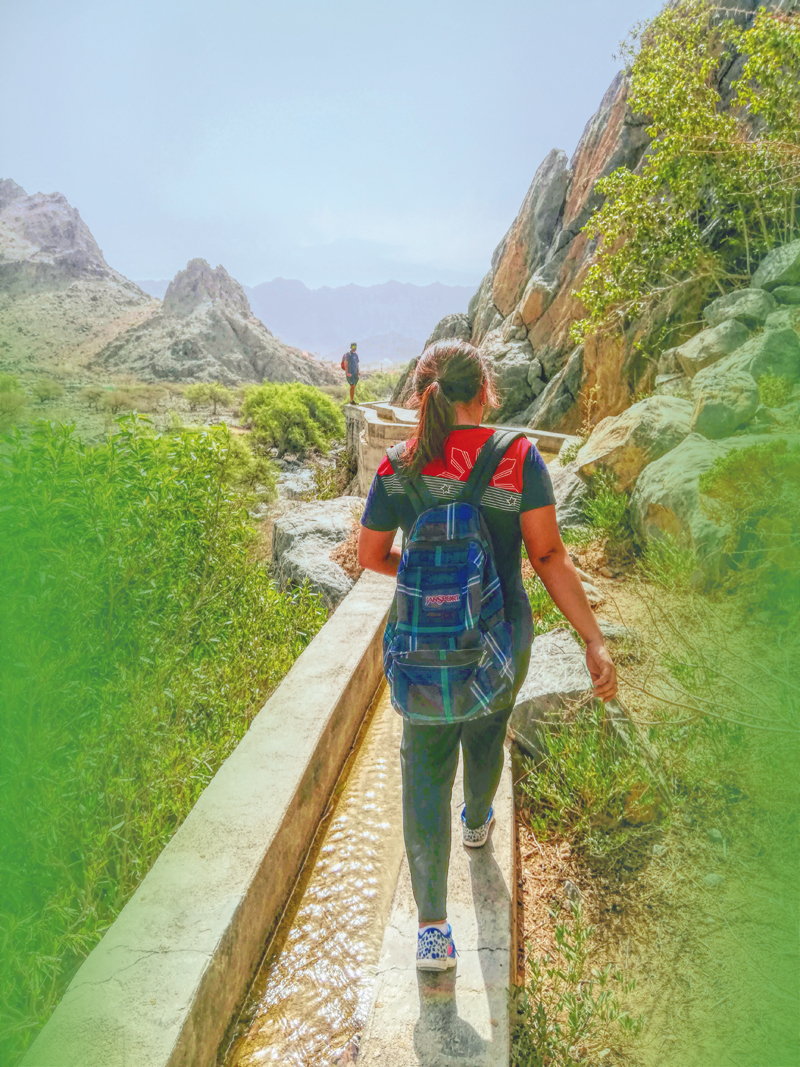

It’s hard to miss the goats. They’d been there as long as the falaj network was built to provide convenient water to the villages nearby. They come in tribes with their kids usually trailing far behind doing their best to keep up with the adults.
For every visitors, they stare at them for a few minutes trying to determine what they are. In the end, their assessment is always that all newcomers are treats so any effort to get close to them is met with panic. And then they run away, expertly navigating the rocky terrain that surrounds Wadi Qurai.




The falaj system of Wadi Qurai is famous amongst hikers all over the Sultanate. It is scenic with minor challenges to help amateur hikers get acquainted with the beauty of trekking.
Located about two hours from Muscat hidden in one of the corners of Samail, Wadi Qurai has maintained its old-world charm and here, the locals are insistent that the impeccable state of nature is preserved.
“We have several rules we want people to abide by when they visit. Number one of those is no swimming on the falaj as these waters are used by the villagers for different purposes — some for cooking and managing their farms and homes,” shared Mohammed who we’ve met while he was tending his goats.
Mohammed shared that although the villagers don’t complain, it is their wish that visitors keep their noise down.
“It’s very quiet here and people are very conscious about their privacy,” he shared.
Our trek was only comprised of three people — a quick getaway organised by Ahmed al Jaabri of Oman Outdoor Adventure as he felt like he needed his weekend breather.
“Many of the people I brought to Wadi Qurai are impressed by the location. It has one of the most amazing falaj network snaking its way into the wadi. The villagers also managed to create this water bridge so that the water can flow directly into the village,” he explained while we were on our way traversing the road leading to Nizwa.
Unlike other wadis, Wadi Qurai is smaller but its packed with a lot of scenes and small pools all made beautiful by thriving lichen and moss. Just as Ahmed described it, the small water bridge which helps people cross to the other side of the wadi as well has been one of the most photographed feature of the wadi. It was a testament to the creativity and ingenuity of the dwellers in the area.
Wadi Qurai also dotted with different trees adding a refreshing green to the surrounding.
“There are many sources of water hidden in the whole of Wadi Qurai. One guy said that there are a total of 19 of these water sources. Although this is yet to be verified, it’s quite interesting hunting them down and I know a few people who’d like to see all of these water sources,” Ahmed shared.
“Anyone can visit Wadi Qurai anytime during the day. It’s a quick trip and I’ve seen children doing this trek. The risks are very minimun and on difficulty level, the trek is definitely just a one. The whole trek can be completed in 20-30 minutes and this already includes several stops for photography among other things,” Ahmed shared.
“I think it’s the biggest pool that is a fitting finale for the whole trek. Measuring about 20 metres by 10 metres and about 3 metres deep, its emerald water filled with small fishes makes the trip worth it. The area surrounding the natural pool is a good spot to lounge around as the canyon provides a good cover from the sun,” he added.
“For me, however, the best time of the day to visit is in the early morning. You can do the trek and then on your way back, you can take a detour to Fanja souk and grab some Omani or Yemeni food on one of the restaurants on the way. That’s usually how we end a good day trek,” he said.
“It’s my first time to do the Wadi Qurai trek. It really is an easy trek and what I love about it is that you don’t have to worry about bringing with you a lot of things cause the whole stretch is just about 30 minutes long. The view and the serenity of the place are worth a day trip,” Jaja Teng, one of the regular trekkers of the group shared.
“We have some problems of people not paying attention to signboard warnings so some villagers took it upon themselves to remind the people of what not to do,” Mohammed shared.
‘While we love to share the beauty of this place to our visitors, livelihoods are dependent upon this falaj so we take utmost care of the surrounding. I hope they always take their garbage with them when they go,” Mohammed said.
YERU EBUEN & TITASH CHAKRABORTY
Oman Observer is now on the WhatsApp channel. Click here



